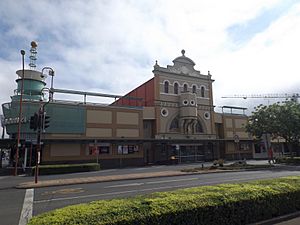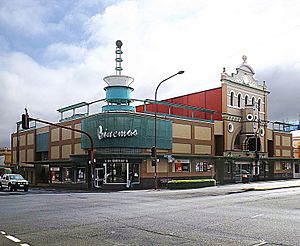Strand Theatre, Toowoomba facts for kids
Quick facts for kids Strand Theatre |
|
|---|---|

Margaret Street side, 2014
|
|
| Location | 159 - 167 Margaret Street, Toowoomba City, Toowoomba, Toowoomba Region, Queensland, Australia |
| Design period | 1914 - 1919 (World War I) |
| Built | 1915 - 1933 |
| Architect | George Henry Male Addison |
| Official name: Strand Theatre | |
| Type | state heritage (built) |
| Designated | 21 October 1992 |
| Reference no. | 600849 |
| Significant period | 1915-1916, 1933 (fabric) 1916-1992 (social) |
| Significant components | proscenium arch, stage/sound shell, auditorium |
| Builders | Luke Halley |
| Lua error in Module:Location_map at line 420: attempt to index field 'wikibase' (a nil value). | |
The Strand Theatre is a historic cinema located at 159 - 167 Margaret Street in Toowoomba City, Toowoomba, Queensland, Australia. It was designed by the famous architect George Henry Male Addison and built between 1915 and 1933. This special building was added to the Queensland Heritage Register on October 21, 1992, meaning it's protected for its historical importance.
Contents
A Look Back: History of the Strand Theatre
This three-story brick cinema was built in 1915-1916 for James Patrick Newman. He was a local council member in Toowoomba City.
Early Days of Cinema in Australia
The theatre was built when movies were becoming super popular in Australia. In the early 1900s, Australia had its own lively film industry. It even competed well with movies from Britain and America! Building cinemas like the Strand helped make going to the movies a respected activity for everyone.
Designing the Theatre
In 1915, Mr. Newman hired George Henry Male Addison, a well-known architect from Brisbane. Addison designed the cinema on Margaret Street, right next to the Crown Hotel. This spot had already been used for outdoor movies since 1914. Luke Halley won the contract to build it.
The design of the Strand Theatre was similar to other cinemas built in Australia around that time. It had a large, round glass arch at the front. What made it unique was that the top floor was designed as extra rooms for the Crown Hotel. You could get to this third floor from the hotel.
Opening Night and Early Changes
Mr. Newman leased the theatre to Senora Spencer, who showed movies. She named it "The Strand," just like her other cinemas in Brisbane and Newcastle. The very first movie screening happened on Saturday, April 15, 1916. The Mayor of Toowoomba even attended the opening ceremony! The Strand Symphony Orchestra played music to go along with the silent films.
In 1918, Union Theatres, a big movie company, took over the lease. They repainted and redecorated the theatre in early 1919. The building even closed for a short time during the Spanish influenza epidemic.
Talkies and Art Deco Style
By the mid-1920s, independent movie companies started leasing the Strand. In 1930, new sound equipment was installed. This meant the Strand was one of the first places in Toowoomba to show "talkies" – movies with sound!
In 1933, the owners decided to give the Strand a fresh new look. They hired Guy Crick, a Sydney architect who was also designing Toowoomba's Empire Theatre. Crick redesigned the inside of the Strand in the popular Art Deco style. At the same time, the first-floor foyer (entrance area) was made bigger.
Movies were so popular during the Great Depression that the Strand kept showing films every evening, even during the renovations! The newly updated theatre officially opened in early December 1933. Local newspapers even said the Strand was the first cinema in Australia to be completely redone in the Art Deco style.
The Strand was very successful in the 1930s. It proudly advertised "Always first with the latest and the greatest." It showed big movies from major studios like Fox and Warner Brothers to huge crowds.
Modern Updates
In 1957, the current owners bought the theatre. They added a wide screen for movies and updated the main foyer in the 1960s and again in the 1970s.
A big renovation of the theatre and nearby buildings happened in 1992. The old Crown Hotel and an amusement center next door were taken down. Four smaller cinemas were built around the original cinema. The old cinema's seats were removed, and it became a large entrance area for the new movie complex.
What the Strand Theatre Looks Like
The Strand Theatre faces Margaret Street. It's a three-story brick building with a hidden roof. The front of the building, called the facade, is very decorative and symmetrical.
Front of the Building
The front has a large, semi-circular arch on the second level. On each side of this arch, there's a window shaped like a four-leaf clover. Above this is a deep cornice (a decorative molding). This design makes the entrance look grander.
A large turret (a small tower) sticks out over the entrance. It has three round windows with colorful leadlight glass. This turret is held up by four large brackets, and there's a statue of a woman holding a lamp. On either side of the turret, there are more leadlight windows.
The third floor has five arched windows, also with Art Nouveau style leadlight panels. Above these is another deep cornice with decorative patterns. The very top has a shaped gable (the triangular part of a wall under a sloping roof) with three large decorative pieces called finials. At street level, there are display arches on either side of the main entrance, with a modern metal awning (a roof-like cover) above.
Inside the Theatre
Not much of the original 1916 decoration remains inside. You can still see the pressed metal ceiling and decorative moldings in the main auditorium. The ground floor foyer has beautiful patterned tiles on the floor.
Some of the 1933 Art Deco decorations are still there. For example, decorative columns called pilasters were added over the existing walls. Special grilles with lyrebird designs were used to cover old window openings. A new air system was also put in. The decorative bands around the stage, called a frieze, are still visible, even though the stage was made wider in the 1950s for bigger screens. The foyer on the mezzanine floor (a floor between two main floors) still has its original 1933 ceiling and wall grilles.
Why the Strand Theatre is Important
The Strand Theatre was added to the Queensland Heritage Register in 1992. This means it's recognized as a very important historical place for several reasons:
A Glimpse into History
The Strand Theatre shows us how movies became a big part of life in Queensland in the 20th century. It helps us understand the history of entertainment.
A Special Kind of Building
It's rare to find a cinema built specifically for movies from the early 1900s. The Strand Theatre is a great example of what those early cinemas looked like and how they were designed.
Beautiful Design
The people of Toowoomba value the Strand Theatre for its beautiful design. Its size, shape, and materials make it stand out on Margaret Street and in the Toowoomba skyline. The Art Deco decorations inside from the 1930s are also very special.
Connection to the Community
The theatre has a strong connection with all the people who have watched movies there over the years, from Toowoomba and the surrounding Darling Downs area.
Famous Architects
The Strand Theatre is also important because it's linked to the work of two famous architects: GHM Addison, who designed the original building, and Guy Crick, who redesigned the interior in the 1930s.
Images for kids




